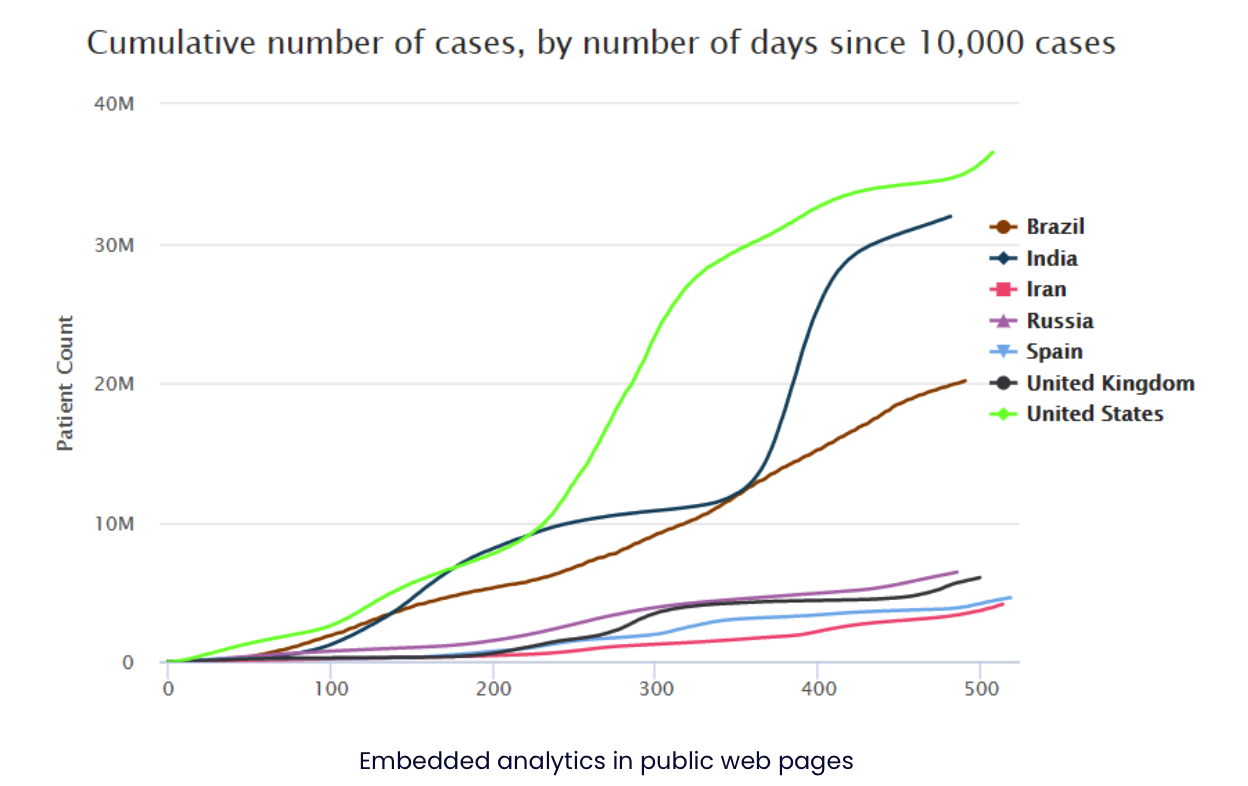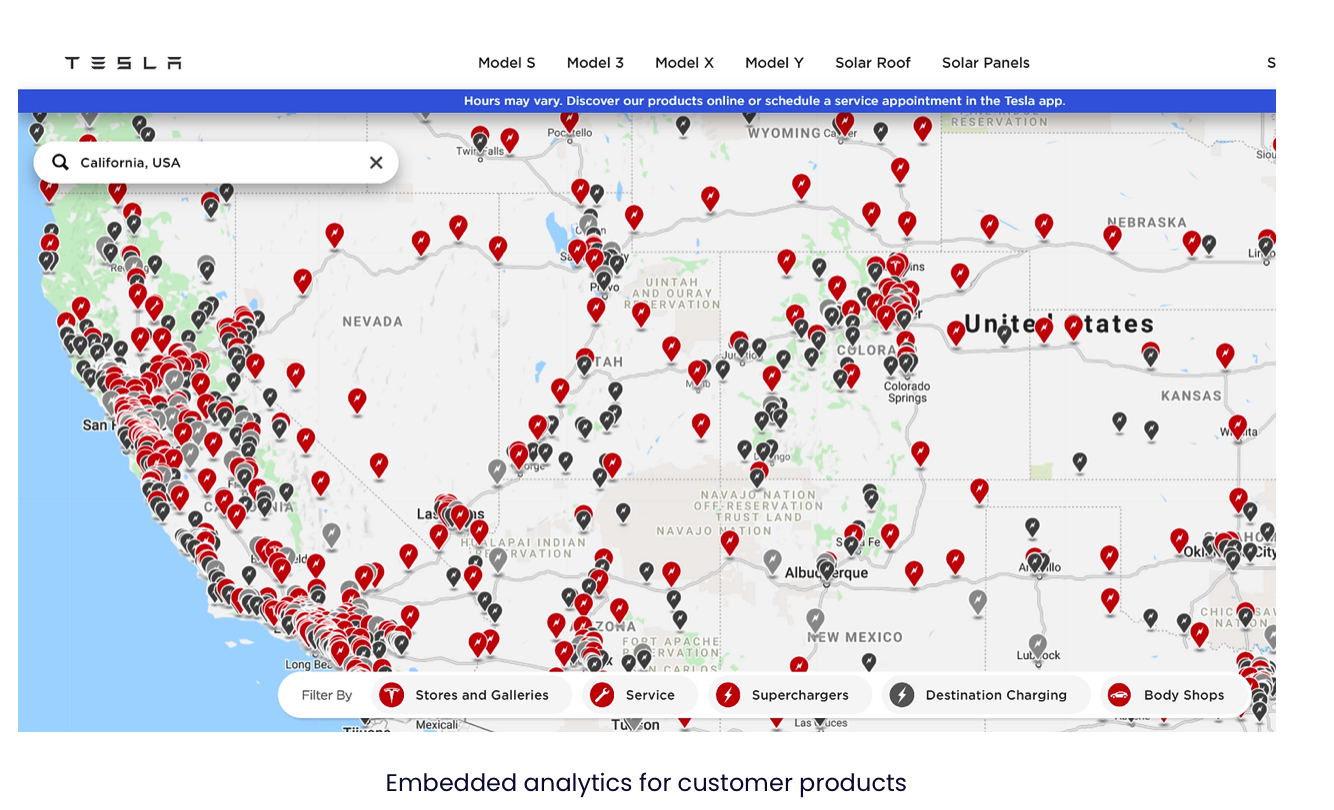Embedded Analytics: Your complete guide 2021 - Definition, examples, and benefits
Imagine that you could place all the data, visualizations, reports and dashboards that a business intelligence (BI) tool provides anywhere you want! That sounds too good to be true, right?
You know what else sounds like a dream? that You could give your team the full benefits of BI without disrupting their productivity and workflows, allowing them to make faster, data-driven decisions.
On top of that, you may make all of the above a paid feature so that your clients can have a deeper understanding of the impact of your business.
That is precisely what embedded analytics is, BI on a silver platter.
A simple explanation of embedded definition is that it enables your data to go beyond the channels and databases it usually exists in and show its worth in surprising ways.
What Does Embedded Analytics Mean?
Embedded analytics refers to integrating a self-service BI tool into non-BI applications (CRM, ERP, EHR/EMR). According to Gartner, "Embedded analytics is a digital workplace capability where data analysis occurs within a user's natural workflow, without the need to toggle to another application."
Embedded analytics makes use of your business software to grant users access to analytics capabilities, all within systems they're already familiar with.
So, rather than requiring users to set up their data queries, it's done for them with ready-to-view data visualization.
How to Use Embedded Analytics?
Embedded analytics is usually used in two scenarios:
1- Internal Role-Based Use
Companies should control access to data and insights in the same way they restrict access to some applications and databases.
For example, your marketing team might want to review the website traffic lead generating ratio, conversion rate, and paid ad spends dashboard. It is past the scope of their role to also gain access to the company's profits, expenditures, burdens, and other financial data within your systems.
You can hide needless data and complexity by using a business intelligence tool, such as Lexer, to embed relevant analytics into the employee workspace and organise their workflow.
2- External Client-Based Use
Embedded analytics is your to-go method if you wish to deliver real-time statistics and analysis to your clients.
This technology allows you to provide real-time insights to your clients rather than providing them with reports at the end of a specific time frame.
Consider a health care provider, for instance. You'll be able to offer each patient a view of their upcoming appointments, diagnosis history, and a treatment plan. An embedded analytics platform like Lexer can easily do this without giving your customers full access to the platform to guarantee the security of your data.
Embedded Analytics Examples
Pioneering businesses around the world are taking steps to create their own embedded analytics platform. By doing so, they enhance customer satisfaction, reduce costs, and generate revenue and profit in the process.
The best part is embedded analytics isn't just for data analysts! It's developed to help your non-technical users employ data-driven knowledge and insight to make smart decisions. Less time is spent on data processing, and more time is spent on analysis that can be put to efficient use.
Here are some examples of how embedded analytics are transforming business operations.
1- Embedded analytics in public web pages
Nowadays, embedded analytics is heavily used on public web pages like news sites. News outlets and other media businesses deliver constantly changing data to their audience using automatically refreshing data visualizations.
The COVID-19 pandemic is a perfect example of how embedded analytics have helped news agencies and healthcare providers gather data easily and keep the average individual seeking information on the matter up to date.
Active cases, death rates, total cases per country, and so much more are now available on various news and public health websites, allowing people to stay informed. You can share graphs, dashboards, and reports that automatically refresh data using a simple HTML embed code that is adjustable to show and hide information as you need.

This chart from Worldometer shows the cumulative number of cases by the number of days and automatically updates as data changes. Users can view the data by country and compare the number of positive cases in no time with interactive visualizations.
2- Embedded analytics in internal web portals
You can embed dashboards into your company's internal web portals for in-house employees or externally for customers and partners. This method allows you to arrange related data reports and visualizations in a single dashboard to add more context to your data.
You'll also gain complete control over Real-time dashboards and control elements, such as filters and input variables and endless possibilities with external integrations.

An excellent analytics example of embedding a dashboard into an internal web portal is this map created by Lexer. The dashboard provides users with quick and precise insights into revenue, costs, and total orders of the company's products with no room for complexity.
3- Embedded analytics in third-party applications
If you want to gain tangible results in increasing productivity within your team, embedding analytics into third-party applications is where you should start. By embedding analytics in the applications your business already uses, you eliminate the time spent in switching between two different systems.
Your team members will be able to access dashboards and visualizations directly within their CRM and ERP to make informed decisions without learning new software or altering their workflow.

The real benefit of embedded analytics impacts sales and marketing departments the most. In the example shown above, a Lexer dashboard is embedded in marketing logistics, allowing users to view marketing leads and gain valuable insights without exiting the SaaS app.
4- Embedded analytics for customer products
Embedding analytics is the ultimate provider of the services required to improve customer satisfaction, decision-making, and data engagement. Most of today's customers need access to accurate and up-to-the-minute information exactly when they need it.
Embedded analytics enables customers to answer their own questions without having to wait for a long time on the phone with the customer support team.

One great example to demonstrate how you can reach an excellent level of customer satisfaction is how a company like Tesla helped its customers find the nearest charging points.
With advanced application embedding capability, customers can access Tesla's superchargers dashboard at any time to find the nearest charging point, easing the huge load on the company's support centre.
Benefits of embedded analytics
With its ability to predict market trends, provide business opportunities, drive decision-making, and do so much more, data analytics has secured its place in almost every business field.
How you might ask? well... Here are 3 of the most important benefits you'll gain from embedding analytics into your application.
1- Improve user satisfaction
Embedded analytics provide customers with a clearer picture of the state of their operations with your business. This will help them make smarter buying decisions and ensure they invest their money in the best way possible. In turn, this will result in increased customer satisfaction and retention.
A happy customer will always come back for what you're offering, which ultimately increase the possibilities of attracting new customers.
As we all know, new customers mean new revenue growth opportunities. So, Businesses can also expect a higher ROI with embedded analytics.
2- Save time and increase productivity
Using business intelligence tools as a stand-alone without integrating embedded analytics capabilities will push you to constantly sync data from your preferred application to the BI tool you're using. This continuous back and forth switch game between your application and the BI solution reduces productivity and the pace of decision making for your organization.
You don't need to waste time on that anymore. Embedded analytics employs BI functionalities straight into your application, allowing users to identify valuable insights without having to understand the complexities of another data analysis tool.
3- Stay on top of the competition
Using the right advanced analytics platform allows your end-users to benefit from new technology to instantly get to the heart of data. When you embed analytics with a BI tool like Lexer, you will gain insights that your competitors will miss.
Providing real-time analytics, innovative reports, and interactive data visualizations and dashboards will help your company gain a competitive edge in the market.
Get Started With Embedded Analytics
It's easy to get started. It takes 3 simple steps to start visualizing all of your data in one place. No coding. No data analysis skills are required. Anyone can start making the right decisions instantly.
With an analytics platform like Lexer, you can deliver data to customers, clients, and employees in the apps they use every day without requiring them to dig through pages of boring stats. Improve SaaS platforms, portals, and websites with visual data dashboards using minimal effort.
What is Lexer?
Lexer is an all-in-one data analytics and visualization tool designed to eliminate technical requirements needed to analyse & visualize all of your data in one place.
Why Lexer?
-
Embed secure and interactive dashboards into any portal.
-
Change, filter & control embedded dashboards and charts right from within the portal, app, or web.
-
Present embedded dashboards and charts in real-time.
-
Embedded dashboards and charts are responsive from the get-go, fit for all screen sizes and devices.
-
Control users’ roles & permissions for embedded dashboards or charts.
-
White-label dashboard/charts to suit your desired look and feel (fonts, colours, images).
Your wow moment is a step away

No Comments Yet
Let us know what you think